Sources of Greenhouse Gas Emissions
Overview
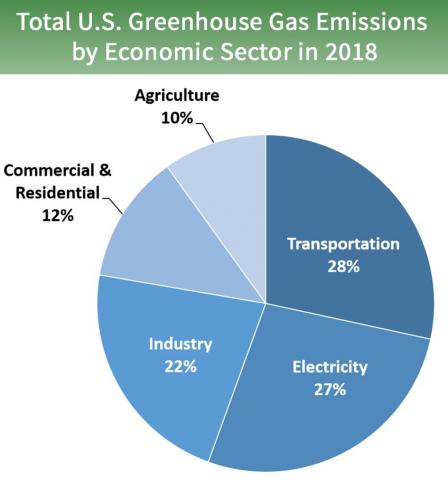 Total Emissions in 2018 = 6,677 Million Metric Tons of CO2 equivalent. Percentages may not add up to 100% due to independent rounding.
Total Emissions in 2018 = 6,677 Million Metric Tons of CO2 equivalent. Percentages may not add up to 100% due to independent rounding.
* Land Use, Land-Use Change, and Forestry in the United States is a net sink and offsets approximately 12 percent of these greenhouse gas emissions, this emissions offset is not included in total above. All emission estimates from the Inventory of U.S. Greenhouse Gas Emissions and Sinks: 1990–2018.
Larger image to save or printGreenhouse gases trap heat and make the planet warmer. Human activities are responsible for almost all of the increase in greenhouse gases in the atmosphere over the last 150 years.1 The largest source of greenhouse gas emissions from human activities in the United States is from burning fossil fuels for electricity, heat, and transportation.
EPA tracks total U.S. emissions by publishing the Inventory of U.S. Greenhouse Gas Emissions and Sinks. This annual report estimates the total national greenhouse gas emissions and removals associated with human activities across the United States.
The primary sources of greenhouse gas emissions in the United States are:
- (28.2 percent of 2018 greenhouse gas emissions) – The transportation sector generates the largest share of greenhouse gas emissions. Greenhouse gas emissions from transportation primarily come from burning fossil fuel for our cars, trucks, ships, trains, and planes. Over 90 percent of the fuel used for transportation is petroleum based, which includes primarily gasoline and diesel.2
- (26.9 percent of 2018 greenhouse gas emissions) – Electricity production generates the second largest share of greenhouse gas emissions. Approximately 63 percent of our electricity comes from burning fossil fuels, mostly coal and natural gas.3
- (22.0 percent of 2018 greenhouse gas emissions) – Greenhouse gas emissions from industry primarily come from burning fossil fuels for energy, as well as greenhouse gas emissions from certain chemical reactions necessary to produce goods from raw materials.
- (12.3 percent of 2018 greenhouse gas emissions) – Greenhouse gas emissions from businesses and homes arise primarily from fossil fuels burned for heat, the use of certain products that contain greenhouse gases, and the handling of waste.
- (9.9 percent of 2018 greenhouse gas emissions) – Greenhouse gas emissions from agriculture come from livestock such as cows, agricultural soils, and rice production.
- (11.6 percent of 2018 greenhouse gas emissions) – Land areas can act as a sink (absorbing CO2 from the atmosphere) or a source of greenhouse gas emissions. In the United States, since 1990, managed forests and other lands are a net sink, i.e. they have absorbed more CO2 from the atmosphere than they emit.
Emissions and Trends
Since 1990, gross U.S. greenhouse gas emissions have increased by 3.7 percent. From year to year, emissions can rise and fall due to changes in the economy, the price of fuel, and other factors. In 2018, U.S. greenhouse gas emissions increased compared to 2017 levels. The increase in CO2 emissions from fossil fuel combustion was a result of multiple factors, including increased energy use due to greater heating and cooling needs due to a colder winter and hotter summer in 2018 compared to 2017.
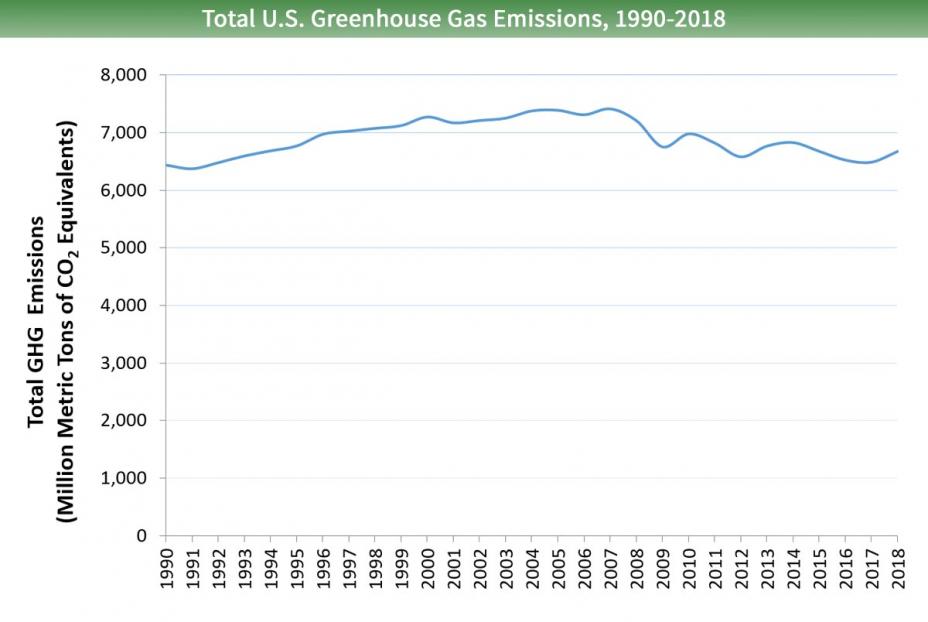 Note: All emission estimates from the Inventory of U.S. Greenhouse Gas Emissions and Sinks: 1990–2018.
Note: All emission estimates from the Inventory of U.S. Greenhouse Gas Emissions and Sinks: 1990–2018.
Larger image to save or print
References
- IPCC (2007). Summary for Policymakers. In: Climate Change 2007: The Physical Science Basis. Exit Contribution of Working Group I to the Fourth Assessment Report of the Intergovernmental Panel on Climate Change [Solomon, S., D. Qin, M. Manning, Z. Chen, M. Marquis, K.B. Averyt, M. Tignor and H.L. Miller (eds.)]. Cambridge University Press, Cambridge, United Kingdom and New York, NY, USA.
- IPCC (2007). Climate Change 2007: Mitigation. (PDF) (863 pp, 24MB) Exit Contribution of Working Group III to the Fourth Assessment Report of the Intergovernmental Panel on Climate Change [B. Metz, O.R. Davidson, P.R. Bosch, R. Dave, L.A. Meyer (eds)], Cambridge University Press, Cambridge, United Kingdom and New York, NY, USA.
- U.S. Energy Information Administration (2019). Electricity Explained - Basics Exit
Electricity Sector Emissions
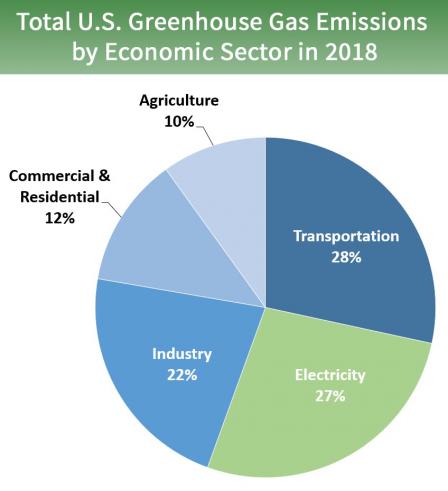 Total Emissions in 2018 = 6,677 Million Metric Tons of CO2 equivalent. Percentages may not add up to 100% due to independent rounding.
Total Emissions in 2018 = 6,677 Million Metric Tons of CO2 equivalent. Percentages may not add up to 100% due to independent rounding.
* Land Use, Land-Use Change, and Forestry in the United States is a net sink and offsets approximately 12 percent of these greenhouse gas emissions, this emissions offset is not included in total above. All emission estimates from the Inventory of U.S. Greenhouse Gas Emissions and Sinks: 1990–2018.
Larger image to save or printThe Electricity sector involves the generation, transmission, and distribution of electricity. Carbon dioxide (CO2) makes up the vast majority of greenhouse gas emissions from the sector, but smaller amounts of methane (CH4) and nitrous oxide (N2O) are also emitted. These gases are released during the combustion of fossil fuels, such as coal, oil, and natural gas, to produce electricity. Less than 1 percent of greenhouse gas emissions from the sector come from sulfur hexafluoride (SF6), an insulating chemical used in electricity transmission and distribution equipment.
Greenhouse Gas Emissions in the Electricity Sector by Fuel Source
Coal combustion is more carbon intensive than burning natural gas or petroleum for electricity. Although coal use accounted for about 65.8 percent of CO2 emissions from the sector, it represented only 28.4 percent of the electricity generated in the United States in 2018. Natural gas use accounted for 34.1 percent of electricity generation in 2018, and petroleum use accounted for less than one percent. The remaining generation in 2018 came from non-fossil fuel sources, including nuclear (20.1 percent) and renewable energy sources (16.7 percent), which include hydroelectricity, biomass, wind, and solar.1 Most of these non-fossil sources, such as nuclear, hydroelectric, wind, and solar, are non-emitting.
Emissions and Trends
In 2018, the electricity sector was the second largest source of U.S. greenhouse gas emissions, accounting for 26.9 percent of the U.S. total. Greenhouse gas emissions from electricity have decreased by about 4.1 percent since 1990 due to a shift in generation to lower- and non-emitting sources of electricity generation and an increase in end-use energy efficiency.
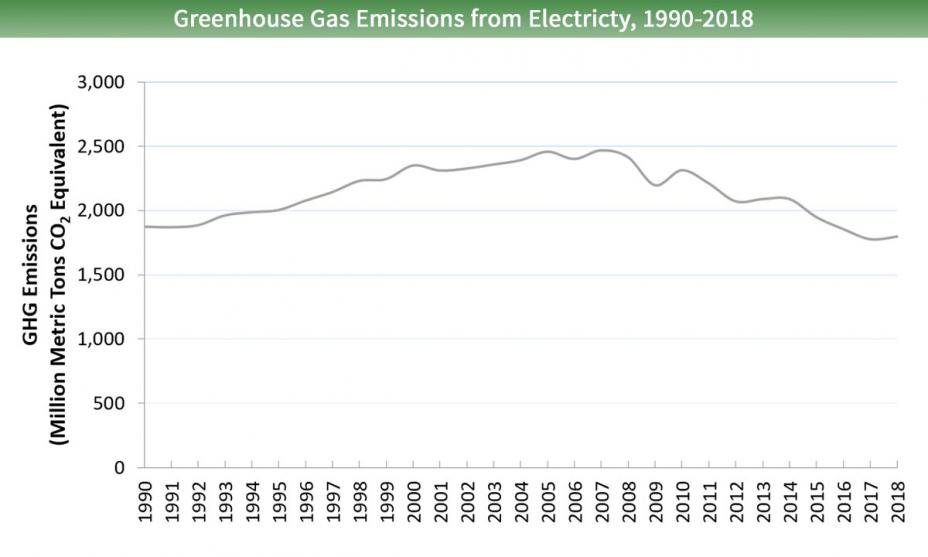 All emission estimates from the Inventory of U.S. Greenhouse Gas Emissions and Sinks: 1990–2018.
All emission estimates from the Inventory of U.S. Greenhouse Gas Emissions and Sinks: 1990–2018.
Larger image to save or print
Greenhouse Gas Emissions by Electricity End-Use
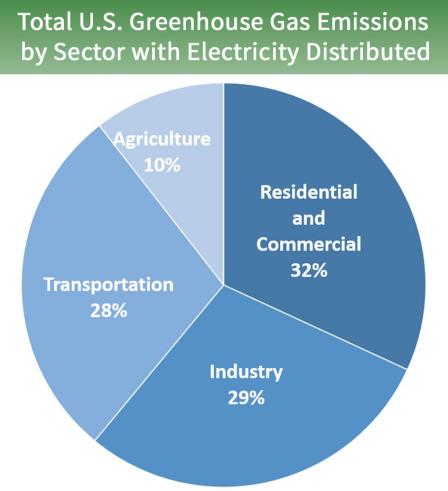 Percentages may not add up to 100% due to independent rounding.
Percentages may not add up to 100% due to independent rounding.
All emission estimates from the Inventory of U.S. Greenhouse Gas Emissions and Sinks: 1990–2018.
Larger image to save or printElectricity is used by other sectors—in homes, businesses, and factories. Therefore, it is possible to attribute the greenhouse gas emissions from electricity generation to the sectors that use the electricity. Looking at greenhouse gas emissions by end-use sector can help us understand energy demand across sectors and changes in energy use over time.
When emissions from electricity generation are allocated to the industrial end-use sector, industrial activities account for a much larger share of U.S. greenhouse gas emissions. Greenhouse gas emissions from commercial and residential buildings also increase substantially when emissions from electricity end-use are included, due to the relatively large share of electricity use (e.g., heating, ventilation, and air conditioning; lighting; and appliances) in these sectors. The transportation sector currently has a relatively low percentage of electricity use but it is growing due to the use of electric and plug-in vehicles.
Reducing Emissions from Electricity
There are a variety of opportunities to reduce greenhouse gas emissions associated with electricity generation, transmission, and distribution. The table below categorizes these opportunities and provides examples. For a more comprehensive list, see Chapter 7 (PDF) (88 pp, 3.6MB) Exit of the Contribution of Working Group III to the Fifth Assessment Report of the Intergovernmental Panel on Climate Change Exit.2
| Type | How Emissions Are Reduced | Examples |
|---|---|---|
| Increased Efficiency of Fossil-fired Power Plants and Fuel Switching | Increasing the efficiency of existing fossil fuel-fired power plants by using advanced technologies; substituting less carbon-intensive fuels; shifting generation from higher-emitting to lower-emitting power plants. |
|
| Renewable Energy | Using renewable energy sources rather than fossil fuel to generate electricity. | Increasing the share of total electricity generated from wind, solar, hydro, and geothermal sources, as well as certain biofuel sources, through the addition of new renewable energy generating capacity. |
| Increased End-Use Energy Efficiency | Reducing electricity use and peak demand by increasing energy efficiency and conservation in homes, businesses, and industry. | EPA's ENERGY STAR® Exit partners avoided over 290 million metric tons of greenhouse gases in 2017 alone, helped Americans save over $30 billion in energy costs, and reduced electricity use by 370 billion kWh. |
| Nuclear Energy | Generating electricity from nuclear energy rather than the combustion of fossil fuels. | Extending the life of existing nuclear plants and building new nuclear generating capacity. |
| Carbon Capture and Sequestration (CCS) | Capturing CO2 as a byproduct of fossil fuel combustion before it enters the atmosphere, transporting the CO2, injecting the CO2 deep underground at a carefully selected and suitable subsurface geologic formation where it is securely stored. | Capturing CO2 from the stacks of a coal-fired power plant and then transferring the CO2 via pipeline, injecting the CO2 deep underground at a carefully selected and suitable nearby abandoned oil field where it is securely stored. Learn more about CCS. |
References
- U.S. Energy Information Administration (2019). Electricity Explained - Basics. Exit
- IPCC (2014). Climate Change 2014: Mitigation of Climate Change (PDF) (1454 pp, 50MB)Exit. Contribution of Working Group III to the Fifth Assessment Report of the Intergovernmental Panel on Climate Change [Edenhofer, O., R. Pichs-Madruga, Y. Sokona, E. Farahani, S. Kadner, K. Seyboth, A. Adler, I. Baum, S. Brunner, P. Eickemeier, B. Kriemann, J. Savolainen, S. Schlömer, C. von Stechow, T. Zwickel and J.C. Minx (eds.)]. Cambridge University Press, Cambridge, United Kingdom and New York, NY, USA.
Transportation Sector Emissions
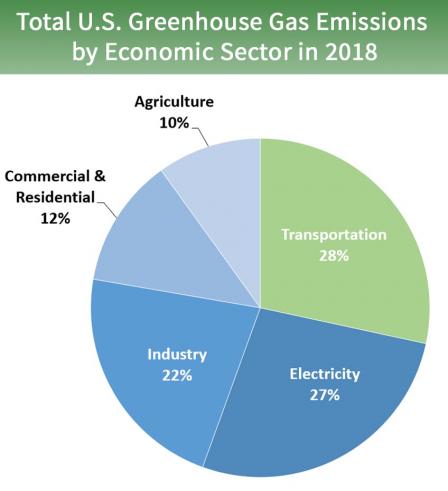 Total Emissions in 2018 = 6,677 Million Metric Tons of CO2 equivalent. Percentages may not add up to 100% due to independent rounding.
Total Emissions in 2018 = 6,677 Million Metric Tons of CO2 equivalent. Percentages may not add up to 100% due to independent rounding.
* Land Use, Land-Use Change, and Forestry in the United States is a net sink and offsets approximately 12 percent of these greenhouse gas emissions, this emissions offset is not included in total above. All emission estimates from the Inventory of U.S. Greenhouse Gas Emissions and Sinks: 1990–2018.
Larger image to save or printThe Transportation sector includes the movement of people and goods by cars, trucks, trains, ships, airplanes, and other vehicles. The majority of greenhouse gas emissions from transportation are carbon dioxide (CO2) emissions resulting from the combustion of petroleum-based products, like gasoline, in internal combustion engines. The largest sources of transportation-related greenhouse gas emissions include passenger cars and light-duty trucks, including sport utility vehicles, pickup trucks, and minivans. These sources account for over half of the emissions from the transportation sector. The remaining greenhouse gas emissions from the transportation sector come from other modes of transportation, including freight trucks, commercial aircraft, ships, boats, and trains, as well as pipelines and lubricants.
Relatively small amounts of methane (CH4) and nitrous oxide (N2O) are emitted during fuel combustion. In addition, a small amount of hydrofluorocarbon (HFC) emissions are included in the Transportation sector. These emissions result from the use of mobile air conditioners and refrigerated transport.
Emissions and Trends
In 2018, greenhouse gas emissions from transportation accounted for about 28.2 percent of total U.S. greenhouse gas emissions, making it the largest contributor of U.S. greenhouse gas emissions. In terms of the overall trend, from 1990 to 2018, total transportation emissions have increased due, in large part, to increased demand for travel. The number of vehicle miles traveled (VMT) by light-duty motor vehicles (passenger cars and light-duty trucks) increased by 46.1 percent from 1990 to 2018, as a result of a confluence of factors including population growth, economic growth, urban sprawl, and periods of low fuel prices. Between 1990 and 2004, average fuel economy among new vehicles sold annually declined, as sales of light-duty trucks increased. Starting in 2005, average new vehicle fuel economy began to increase while light-duty VMT grew only modestly for much of the period. Average new vehicle fuel economy has improved almost every year since 2005 slowing the rate of increase of CO2 emissions, and the truck share is about 52 percent of new vehicles in model year 2018.
Learn more about Greenhouse Gas Emissions from Transportation.
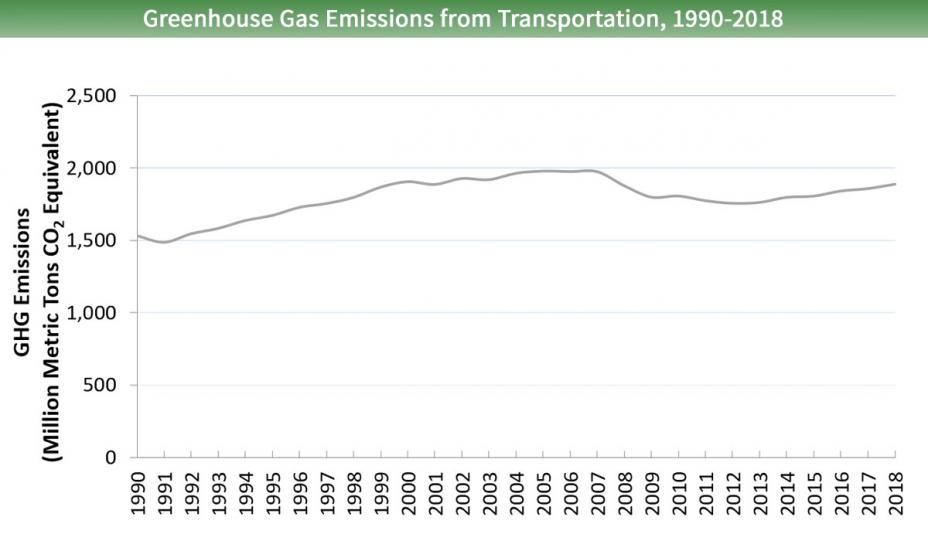 Emissions involved in the consumption of electricity for transportation activities are included above, but not shown separately (as was done for other sectors). These indirect emissions are negligible, accounting for less than 1 percent of the total emissions shown in the graph.
Emissions involved in the consumption of electricity for transportation activities are included above, but not shown separately (as was done for other sectors). These indirect emissions are negligible, accounting for less than 1 percent of the total emissions shown in the graph.
All emission estimates from the Inventory of U.S. Greenhouse Gas Emissions and Sinks: 1990–2018.
Larger image to save or print
Reducing Emissions from Transportation
There are a variety of opportunities to reduce greenhouse gas emissions associated with transportation. The table shown below categorizes these opportunities and provides examples. For a more comprehensive list, see Chapter 8 of the Contribution of Working Group III to the Fifth Assessment Report of the Intergovernmental Panel on Climate Change Exit.1
| Type | How Emissions Are Reduced | Examples |
|---|---|---|
| Fuel Switching | Using fuels that emit less CO2 than fuels currently being used. Alternative sources can include biofuels; hydrogen; electricity from renewable sources, such as wind and solar; or fossil fuels that are less CO2-intensive than the fuels that they replace. Learn more about Green Vehicles and Alternative and Renewable Fuels. |
|
| Improving Fuel Efficiency with Advanced Design, Materials, and Technologies | Using advanced technologies, design, and materials to develop more fuel-efficient vehicles. Learn about EPA's vehicle greenhouse gas rules. |
|
| Improving Operating Practices | Adopting practices that minimize fuel use. Improving driving practices and vehicle maintenance. Learn about how the freight transportation industry can reduce emissions through EPA's SmartWay Program. |
|
| Reducing Travel Demand | Employing urban planning to reduce the number of miles that people drive each day. Reducing the need for driving through travel efficiency measures such as commuter, biking, and pedestrian programs. Learn about EPA's Smart Growth Program. |
|
References
- IPCC (2014). Climate Change 2014: Mitigation of Climate Change (PDF) (1454 pp, 50 MB) Exit. Contribution of Working Group III to the Fifth Assessment Report of the Intergovernmental Panel on Climate Change [Edenhofer, O., R. Pichs-Madruga, Y. Sokona, E. Farahani, S. Kadner, K. Seyboth, A. Adler, I. Baum, S. Brunner, P. Eickemeier, B. Kriemann, J. Savolainen, S. Schlömer, C. von Stechow, T. Zwickel and J.C. Minx (eds.)]. Cambridge University Press, Cambridge, United Kingdom and New York, NY, USA.
Industry Sector Emissions
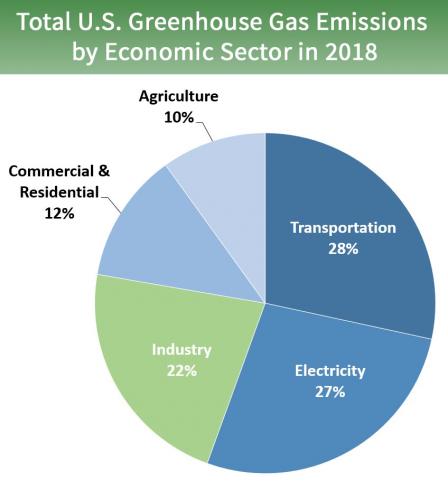 Total Emissions in 2018 = 6,677 Million Metric Tons of CO2 equivalent. Percentages may not add up to 100% due to independent rounding.
Total Emissions in 2018 = 6,677 Million Metric Tons of CO2 equivalent. Percentages may not add up to 100% due to independent rounding.
* Land Use, Land-Use Change, and Forestry in the United States is a net sink and offsets approximately 12 percent of these greenhouse gas emissions, this emissions offset is not included in total above. All emission estimates from the Inventory of U.S. Greenhouse Gas Emissions and Sinks: 1990–2018.
Larger image to save or printThe Industry sector produces the goods and raw materials we use every day. The greenhouse gases emitted during industrial production are split into two categories: direct emissions that are produced at the facility, and indirect emissions that occur off site, but are associated with the facility's use of electricity.
Direct emissions are produced by burning fuel for power or heat, through chemical reactions, and from leaks from industrial processes or equipment. Most direct emissions come from the consumption of fossil fuels for energy. A smaller amount of direct emissions, roughly one third, come from leaks from natural gas and petroleum systems, the use of fuels in production (e.g., petroleum products used to make plastics), and chemical reactions during the production of chemicals, iron and steel, and cement.
Indirect emissions are produced by burning fossil fuel at a power plant to make electricity, which is then used by an industrial facility to power industrial buildings and machinery.
More information about facility-level emissions from large industrial sources is available through EPA's Greenhouse Gas Reporting Program's data publication tool. National-level information about emissions from industry as a whole can be found in the sections on Fossil Fuel Combustion and the Industrial Processes chapter in the Inventory of U.S. Greenhouse Gas Emissions and Sinks.
Emissions and Trends
In 2018, direct industrial greenhouse gas emissions accounted for 22 percent of total U.S. greenhouse gas emissions, making it the third largest contributor to U.S. greenhouse gas emissions, after the Transportation and Electricity sectors. Including both direct emissions and indirect emissions associated with electricity use, industry's share of total U.S. greenhouse gas emissions in 2018 was 28.9 percent, making it the largest contributor of greenhouse gases of any sector. Total U.S. greenhouse gas emissions from industry, including electricity, have declined by 16.1 percent since 1990.
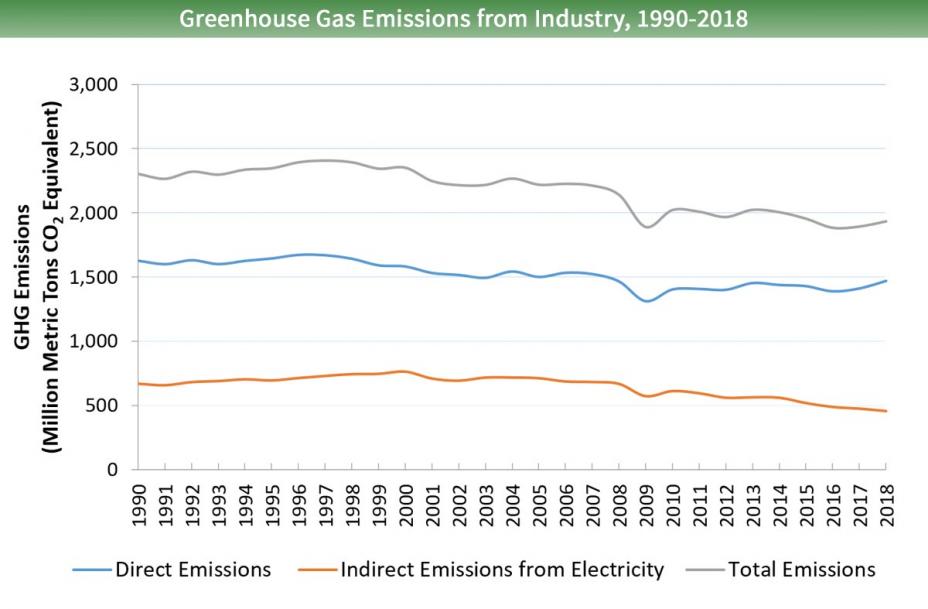 All emission estimates from the Inventory of U.S. Greenhouse Gas Emissions and Sinks: 1990–2018.
All emission estimates from the Inventory of U.S. Greenhouse Gas Emissions and Sinks: 1990–2018.
Larger image to save or print
Reducing Emissions from Industry
There are a wide variety of industrial activities that cause greenhouse gas emissions, and many opportunities to reduce them. The table shown below provides some examples of opportunities for industry to reduce emissions. For a more comprehensive list, see Chapter 10 of the Contribution of Working Group III to the Fifth Assessment Report of the Intergovernmental Panel on Climate Change Exit. 1
| Type | How Emissions Are Reduced | Examples |
|---|---|---|
| Energy Efficiency | Upgrading to more efficient industrial technology. EPA's ENERGY STAR® Exit program helps industries become more energy-efficient. | Identifying the ways that manufacturers Exit can use less energy to light and heat factories or to run equipment. |
| Fuel Switching | Switching to fuels that result in less CO2 emissions but the same amount of energy, when combusted. | Using natural gas instead of coal to run machinery. |
| Recycling | Producing industrial products from materials that are recycled or renewable, rather than producing new products from raw materials. | Using scrap steel and scrap aluminum as opposed to smelting new aluminum or forging new steel. |
| Training and Awareness | Making companies and workers aware of the steps to reduce or prevent emissions leaks from equipment. EPA has a variety of voluntary programs that provide resources for training and other steps for reducing emissions. EPA supports programs for the aluminum, semiconductor, and magnesium industries. | Instituting handling policies and procedures for perfluorocarbons (PFCs), hydrofluorocarbons (HFCs), and sulfur hexafluoride (SF6) that reduce occurrences of accidental releases and leaks from containers and equipment. |
References
- IPCC (2014). Climate Change 2014: Mitigation of Climate Change (PDF) (1454 pp, 50 MB) Exit. Contribution of Working Group III to the Fifth Assessment Report of the Intergovernmental Panel on Climate Change [Edenhofer, O., R. Pichs-Madruga, Y. Sokona, E. Farahani, S. Kadner, K. Seyboth, A. Adler, I. Baum, S. Brunner, P. Eickemeier, B. Kriemann, J. Savolainen, S. Schlömer, C. von Stechow, T. Zwickel and J.C. Minx (eds.)]. Cambridge University Press, Cambridge, United Kingdom and New York, NY, USA.
Commercial and Residential Sector Emissions
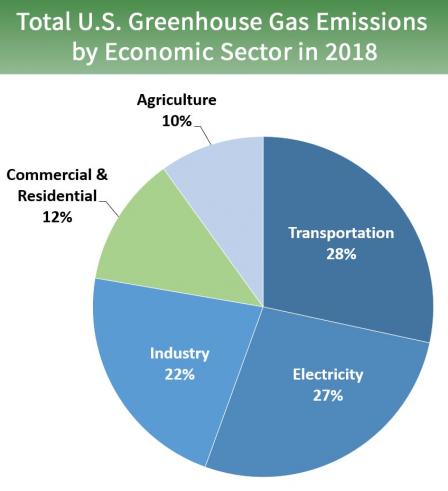 Total Emissions in 2018 = 6,677 Million Metric Tons of CO2 equivalent. Percentages may not add up to 100% due to independent rounding.
Total Emissions in 2018 = 6,677 Million Metric Tons of CO2 equivalent. Percentages may not add up to 100% due to independent rounding.
* Land Use, Land-Use Change, and Forestry in the United States is a net sink and offsets approximately 12 percent of these greenhouse gas emissions, this emissions offset is not included in total above. All emission estimates from the Inventory of U.S. Greenhouse Gas Emissions and Sinks: 1990–2018.
Larger image to save or printThe residential and commercial sectors include all homes and commercial businesses (excluding agricultural and industrial activities). Greenhouse gas emissions from this sector come from direct emissions including fossil fuel combustion for heating and cooking needs, management of waste and wastewater, and leaks from refrigerants in homes and businesses as well as indirect emissions that occur offsite but are associated with use of electricity consumed by homes and businesses.
Direct emissions are produced from residential and commercial activities in a variety of ways:
- Combustion of natural gas and petroleum products for heating and cooking needs emits carbon dioxide (CO2), methane (CH4), and nitrous oxide (N2O). Emissions from natural gas consumption represent 79.9 percent of the direct fossil fuel CO2 emissions from the residential and commercial sectors in 2018. Coal consumption is a minor component of energy use in both of these sectors.
- Organic waste sent to landfills emits CH4.
- Wastewater treatment plants emit CH4 and N2O.
- Fluorinated gases (mainly hydrofluorocarbons, or HFCs) used in air conditioning and refrigeration systems can be released during servicing or from leaking equipment.
Indirect emissions are produced by burning fossil fuel at a power plant to make electricity, which is then used in residential and commercial activities such as lighting and for appliances.
More national-level information about emissions from the residential and commercial sectors can be found in the U.S. Inventory's Energy and Trends chapters.
Emissions and Trends
In 2018, direct greenhouse gas emissions from homes and businesses accounted for 12.3 percent of total U.S. greenhouse gas emissions. Greenhouse gas emissions from homes and businesses vary from year to year often correlated with seasonal fluctuations in energy use caused primarily by weather conditions. Total residential and commercial greenhouse gas emissions, including direct and indirect emissions, in 2018 have increased by 9.0 percent since 1990. Greenhouse gas emissions from on-site direct emissions in homes and businesses have increased by 5.9 percent since 1990. Additionally, indirect emissions from electricity use by homes and businesses have increased by 11.1 percent since 1990, due to increasing electricity consumption for lighting, heating, air conditioning, and appliances.
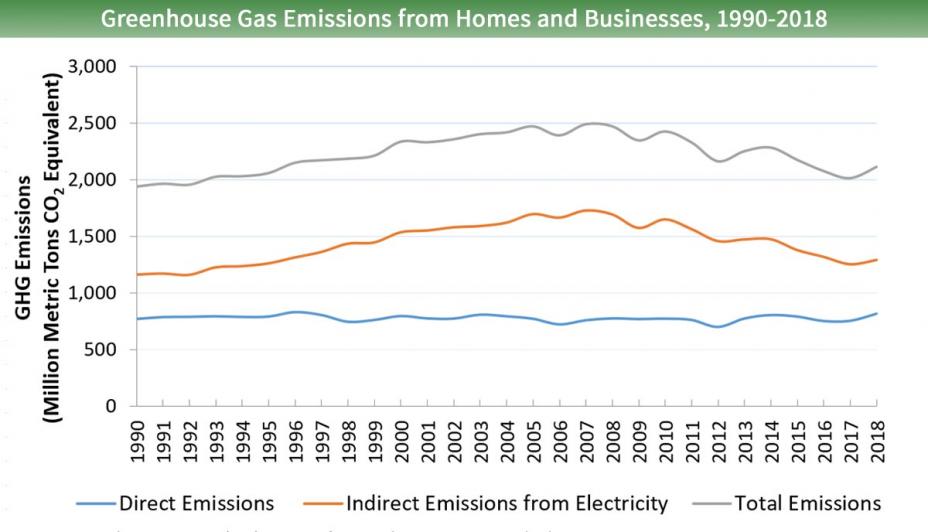 All emission estimates from the Inventory of U.S. Greenhouse Gas Emissions and Sinks: 1990–2018.
All emission estimates from the Inventory of U.S. Greenhouse Gas Emissions and Sinks: 1990–2018.
Larger image to save or print
Reducing Emissions from Homes and Businesses
The table shown below provides some examples of opportunities to reduce emissions from homes and businesses. For a more comprehensive list of options and a detailed assessment of how each option affects different gases, see Chapter 9 and Chapter 12 of the Contribution of Working Group III to the Fifth Assessment Report of the Intergovernmental Panel on Climate Change. Exit
| Type | How Emissions Are Reduced | Examples |
|---|---|---|
| Homes and Commercial Buildings | Reducing energy use through energy efficiency. | Homes and commercial buildings use large amounts of energy for heating, cooling, lighting, and other functions. "Green building" techniques and retrofits can allow new and existing buildings to use less energy to accomplish the same functions, leading to fewer greenhouse gas emissions. Techniques to improve building energy efficiency include better insulation; more energy-efficient heating, cooling, ventilation, and refrigeration systems; efficient fluorescent lighting; passive heating and lighting to take advantage of sunlight; and the purchase of energy-efficient appliances and electronics. Learn more about ENERGY STAR®. |
| Wastewater Treatment | Making water and wastewater systems more energy-efficient. | Drinking water and wastewater systems account for approximately 2 percent of energy use in the United States. By incorporating energy efficiency practices into their water and wastewater plant, municipalities and utilities can save 15 to 30 percent in energy use. Learn more about Energy Efficiency for Water and Wastewater Utilities. |
| Waste Management | Reducing solid waste sent to landfills. Capturing and using methane produced in current landfills. | Landfill gas is the natural byproduct of the decomposition of solid waste in landfills. It primarily consists of CO2 and CH4. Well established, low-cost methods to reduce greenhouse gases from consumer waste exist, including recycling programs, waste reduction programs, and landfill methane capture programs.
|
| Air Conditioning and Refrigeration | Reducing leakage from air conditioning and refrigeration equipment. Using refrigerants with lower global warming potentials. | Commonly used refrigerants in homes and businesses include ozone-depleting hydrochlorofluorocarbon (HCFC) refrigerants, often HCFC-22, and blends consisting entirely or primarily of hydrofluorocarbons (HFCs), both of which are potent greenhouse gases. In recent years there have been several advancements in air conditioning and refrigeration technology that can help food retailers reduce both refrigerant charges and refrigerant emissions. Learn more about EPA's GreenChill Program to reduce greenhouse gas emissions from supermarkets. |
Agriculture Sector Emissions
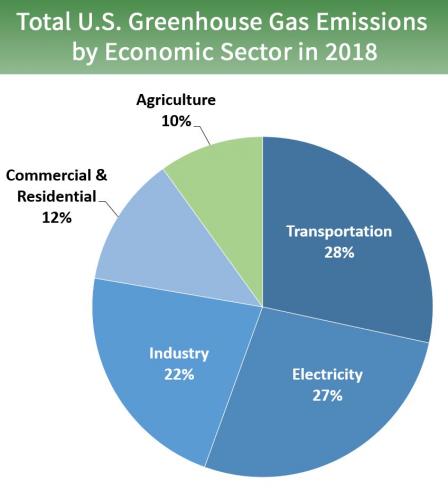 Total Emissions in 2018 = 6,677 Million Metric Tons of CO2 equivalent. Percentages may not add up to 100% due to independent rounding.
Total Emissions in 2018 = 6,677 Million Metric Tons of CO2 equivalent. Percentages may not add up to 100% due to independent rounding.
* Land Use, Land-Use Change, and Forestry in the United States is a net sink and offsets approximately 12 percent of these greenhouse gas emissions, this emissions offset is not included in total above. All emission estimates from the Inventory of U.S. Greenhouse Gas Emissions and Sinks: 1990–2018.
Larger image to save or printAgricultural activities — crop and livestock production for food — contribute to emissions in a variety of ways:
- Various management practices on agricultural soils can lead to increased availability of nitrogen in the soil and result in emissions of nitrous oxide (N2O). Specific activities that contribute to N2O emissions from agricultural lands include the application of synthetic and organic fertilizers, the growth of nitrogen-fixing crops, the drainage of organic soils, and irrigation practices. Management of agricultural soils accounts for just over half of the N2O emissions from the Agriculture economic sector.*
- Livestock, especially ruminants such as cattle, produce methane (CH4) as part of their normal digestive processes. This process is called enteric fermentation, and it represents over a quarter of the emissions from the Agriculture economic sector.
- The way in which manure from livestock is managed also contributes to CH4 and N2O emissions. Different manure treatment and storage methods affect how much of these greenhouse gases are produced. Manure management accounts for about 12 percent of the total greenhouse gas emissions from the Agriculture economic sector in the United States.
- Smaller sources of agricultural emissions include CO2 from liming and urea application, CH4 from rice cultivation, and burning crop residues, which produces CH4 and N2O.
More information about emissions from agriculture can be found in the agriculture chapter in the Inventory of U.S. Greenhouse Gas Emissions and Sinks.
* Management of croplands and grasslands can also lead to emissions or sequestration of carbon dioxide (CO2). However, these emissions and removals are included under the Land Use, Land-Use Change, and Forestry sector.
Emissions and Trends
In 2018, greenhouse gas emissions from the agriculture economic sector accounted for 9.9 percent of total U.S. greenhouse gas emissions. Greenhouse gas emissions from agriculture have increased by 10.1 percent since 1990. Drivers for this increase include a 7 percent increase in N2O from management of soils, along with a 58.7 percent growth in combined CH4 and N2O emissions from livestock manure management systems, reflecting the increased use of emission-intensive liquid systems over this time period. Emissions from other agricultural sources have generally remained flat or changed by a relatively small amount since 1990.
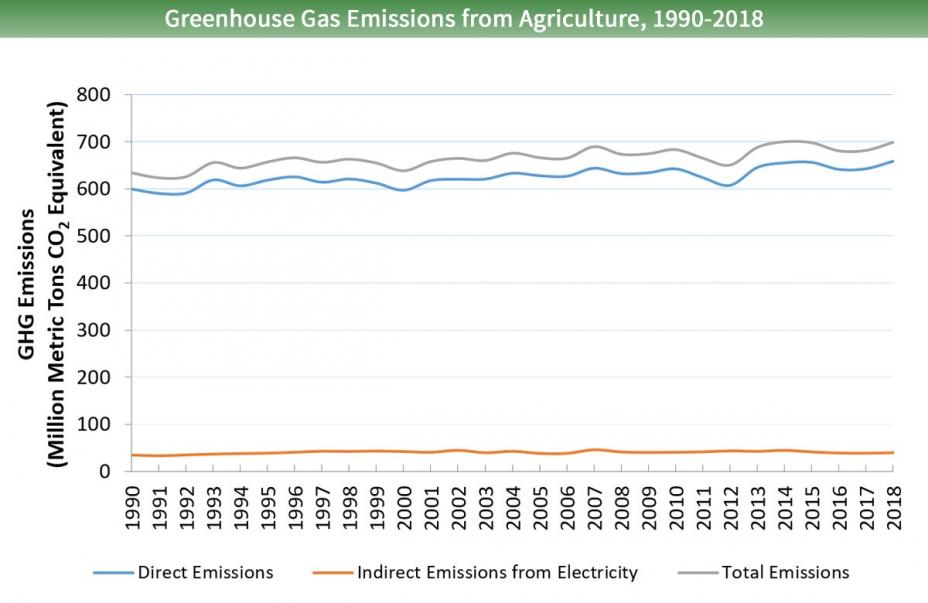 All emission estimates from the Inventory of U.S. Greenhouse Gas Emissions and Sinks: 1990–2018.
All emission estimates from the Inventory of U.S. Greenhouse Gas Emissions and Sinks: 1990–2018.
Larger image to save or print
Reducing Emissions from Agriculture
The table shown below provides some examples of opportunities to reduce emissions from agriculture. For a more comprehensive list of options and a detailed assessment of how each option affects different gases, see Chapter 11 of the Contribution of Working Group III to the Fifth Assessment Report of the Intergovernmental Panel on Climate Change. Exit
| Type | How Emissions Are Reduced | Examples |
|---|---|---|
| Land and Crop Management | Adjusting the methods for managing land and growing crops. |
|
| Livestock Management | Adjusting feeding practices and other management methods to reduce the amount of methane resulting from enteric fermentation. |
|
| Manure Management |
|
|
Land Use, Land-Use Change, and Forestry Sector Emissions and Sequestration
Plants absorb carbon dioxide (CO2) from the atmosphere as they grow, and they store some of this carbon as aboveground and belowground biomass throughout their lifetime. Soils and dead organic matter/litter can also store some of the carbon from these plants depending on how the soil is managed and other environmental conditions (e.g., climate). This storage of carbon in plants, dead organic matter/litter and soils is called biological carbon sequestration. Because biological sequestration takes CO2 out of the atmosphere and stores it in these carbon pools, it is also called a carbon "sink."
Emissions or sequestration of CO2, as well as emissions of CH4 and N2O can occur from management of lands in their current use or as lands are converted to other land uses. Carbon dioxide is exchanged between the atmosphere and the plants and soils on land, for example, as cropland is converted into grassland, as lands are cultivated for crops, or as forests grow. In addition, using biological feedstocks (such as energy crops or wood) for purposes such as electricity generation, as inputs to processes that create liquid fuels, or as building materials can lead to emissions or sequestration.*
In the United States overall, since 1990, Land Use, Land-Use Change, and Forestry (LULUCF) activities have resulted in more removal of CO2 from the atmosphere than emissions. Because of this, the LULUCF sector in the United States is considered a net sink, rather than a source, of CO2 over this time-period. In many areas of the world, the opposite is true, particularly in countries where large areas of forest land are cleared, often for conversion to agricultural purposes or for settlements. In these situations, the LULUCF sector can be a net source of greenhouse gas emissions.
- More national-level information about land use, land-use change, and forestry is available from the Land Use, Land-Use Change, and Forestry chapter in the Inventory of U.S. Greenhouse Gas Emissions and Sinks. For more information on emissions and sequestration from forest land and urban trees in settlement areas, see also the USFS Resource Update. Exit
- For more information about global emissions from land use and forestry activities, see EPA's Global Greenhouse Gas emissions page and the Contribution of Working Group III to the Fifth Assessment Report of the Intergovernmental Panel on Climate Change. Exit
* Emissions and sequestration of CO2 are presented under the Land Use, Land-Use Change, and Forestry sector in the Inventory. Emissions of methane (CH4) and nitrous oxide (N2O) also occur as a result of land use and management activities in the LULUCF sector. Other emissions from CH4 and N2O are also presented in the Energy sector.
Emissions and Trends
In 2018, the net CO2 removed from the atmosphere from the LULUCF sector was 11.6 percent of total U.S. greenhouse gas emissions. Between 1990 and 2018, total carbon sequestration in the LULUCF sector decreased by 7.1 percent, primarily due to a decrease in the rate of net carbon accumulation in forests and cropland, as well as an increase in CO2 emissions from urbanization. Additionally, while episodic in nature, increased CO2, CH4 and N2O emissions from forest fires have also occurred over the time series.
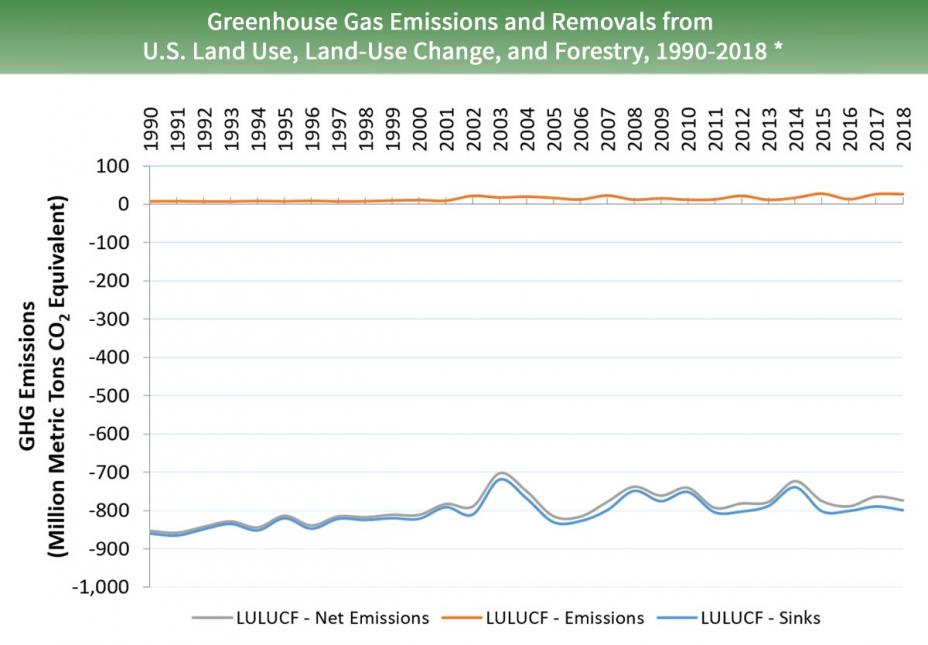 *Note: The LULUCF sector is a net "sink" of emissions in the United States (e.g., more greenhouse gas emissions are sequestered than emitted from land use activities), so net greenhouse gas emissions from LULUCF are negative.
*Note: The LULUCF sector is a net "sink" of emissions in the United States (e.g., more greenhouse gas emissions are sequestered than emitted from land use activities), so net greenhouse gas emissions from LULUCF are negative.
All emission estimates from the Inventory of U.S. Greenhouse Gas Emissions and Sinks: 1990–2018.
Larger image to save or print
Reducing Emissions and Enhancing Sinks from Land Use, Land-Use Change, and Forestry
In the LULUCF sector, opportunities exist to reduce emissions and increase the potential to sequester carbon from the atmosphere by enhancing sinks. The table shown below provides some examples of opportunities for both reducing emissions and enhancing sinks. For a more comprehensive list, see Chapter 11 of the Contribution of Working Group III to the Fifth Assessment Report of the Intergovernmental Panel on Climate Change. Exit
| Type | How Emissions Are Reduced or Sinks Are Enhanced | Examples |
|---|---|---|
| Change in Uses of Land | Increasing carbon storage by using land differently or maintaining carbon storage by avoiding land degradation. |
|
| Changes in Land Management Practices | Improving management practices on existing land-use types. |
|
